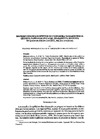Identificador persistente para citar o vincular este elemento:
https://accedacris.ulpgc.es/handle/10553/47960
| Campo DC | Valor | idioma |
|---|---|---|
| dc.contributor.author | Morales Ayala, Soledad | en_US |
| dc.contributor.author | Viera Rodríguez, María Ascensión | en_US |
| dc.date.accessioned | 2018-11-23T17:50:17Z | - |
| dc.date.available | 2018-11-23T17:50:17Z | - |
| dc.date.issued | 1989 | en_US |
| dc.identifier.issn | 0211-1322 | en_US |
| dc.identifier.other | Dialnet | - |
| dc.identifier.uri | https://accedacris.ulpgc.es/handle/10553/47960 | - |
| dc.description.abstract | Se ha estudiado la distribución de los epífitos, con exclusión de diatomeas, sobre Cystoseira tamariscifolia (Hudson) Papenfuss, distinguiendo tres zonas en el forófito: disco, estipe y ramas. Se reconoce un total de 72 especies epífitas. El estipe es la región más epifitada, con 56 especies; seguida por las ramas, con 44; mientras que el disco es el menos epifitado, con 18. Por grupos son las rodofitas las más representadas en las tres zonas del forófito, lo que concuerda con la dominancia de este grupo en el conjunto de la flora bentónica de las Islas Canarias | - |
| dc.description.abstract | Epiphyte algal distribution on Cystoseira tamariscifolia has been studied. Diatoms were excluded. The host was studied in three áreas: holdfast, stipe and branches. 72 species were identified: 56 on the holdfast, 44 on the stipe and 18 on the branches. Rhodophyta is the more represented group, in keeping with the preponderaney of this group in all the benthic marine flora of the Canary Islands. | - |
| dc.language | spa | en_US |
| dc.relation.ispartof | Anales del Jardin Botanico de Madrid | en_US |
| dc.source | Anales del Jardín Botánico de Madrid [ISSN 0211-1322], v. 46 (1), p. 107-113 | en_US |
| dc.subject | 241703 Botánica general | - |
| dc.subject.other | Cystoseira tamariscifolia | - |
| dc.subject.other | Epiphytes | - |
| dc.subject.other | Gran Canaria (Canary Islands) | - |
| dc.title | Distribución de los epífitos en "Cystoseira tamariscifolia" (Hudson) Papenfuss ("Fucales, Phaeophyta") en punta de Gáldar (Gran Canaria, Islas Canarias) | en_US |
| dc.title.alternative | Distribution of epiphytes on Cystoseira tamariscifolia (Hudson) Papenfuss (Fucales, Phaeophyta) in Galdar Point (Gran Canaria, Canary Islands) | en_US |
| dc.type | info:eu-repo/semantics/article | en_US |
| dc.type | Article | en_US |
| dc.identifier.scopus | 0024931379 | - |
| dc.identifier.url | http://dialnet.unirioja.es/servlet/articulo?codigo=2955203 | - |
| dc.contributor.authorscopusid | 6505508396 | - |
| dc.contributor.authorscopusid | 6504450075 | - |
| dc.description.lastpage | 113 | - |
| dc.identifier.issue | 1 | - |
| dc.description.firstpage | 107 | - |
| dc.relation.volume | 46 | - |
| dc.investigacion | Ciencias | - |
| dc.type2 | Artículo | en_US |
| dc.contributor.authordialnetid | No ID | - |
| dc.contributor.authordialnetid | 1285849 | - |
| dc.identifier.dialnet | 2955203ARTREV | - |
| dc.utils.revision | Sí | - |
| dc.identifier.ulpgc | Sí | es |
| dc.description.scie | SCIE | |
| item.grantfulltext | open | - |
| item.fulltext | Con texto completo | - |
| crisitem.author.dept | GIR ECOAQUA: Ecofisiología de Organismos Marinos | - |
| crisitem.author.dept | IU de Investigación en Acuicultura Sostenible y Ec | - |
| crisitem.author.orcid | 0000-0002-6423-619X | - |
| crisitem.author.parentorg | IU de Investigación en Acuicultura Sostenible y Ec | - |
| crisitem.author.fullName | Viera Rodríguez,María Ascensión | - |
| Colección: | Artículos | |
Citas SCOPUSTM
10
actualizado el 08-jun-2025
Visitas
129
actualizado el 24-ago-2024
Descargas
64
actualizado el 24-ago-2024
Google ScholarTM
Verifica
Comparte
Exporta metadatos
Los elementos en ULPGC accedaCRIS están protegidos por derechos de autor con todos los derechos reservados, a menos que se indique lo contrario.
